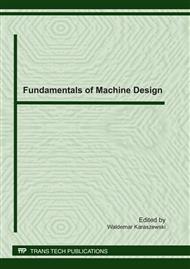[1]
J. Sep, The oil film properties in journal bearings with non-typical geometry. Rzeszow University of Technology, Rzeszow 2006 (in polish).
Google Scholar
[2]
M. Szczerek, M. Wiśniewski M.: Tribology and tribo-technique. Institute for Sustainable Technologies, Radom 2000 (in polish).
Google Scholar
[3]
S.A. McKee, Effect on abrasive in lubricant. Journal of S.A.E, 20 (1927) 3-6.
Google Scholar
[4]
A.E. Roach, Performance of oil-film bearings with abrasive-containing lubricant. Transactions ASME, 73 (1951) 677-686.
DOI: 10.1115/1.4016383
Google Scholar
[5]
H.G. Rylander, Effects of solid inclusions in sleeve-bearing oil supply. Mech. Eng., 74 (1952) 963-966.
Google Scholar
[6]
J.A Williams, A.M. Hyncica, Mechanisms of abrasive wear in lubricated contacts. Wear, 152 (1992) 57-74.
DOI: 10.1016/0043-1648(92)90204-l
Google Scholar
[7]
V. Wikström, E. Höglund, R. Larsson R, Wear of bearing liners at low speed rotation of shafts with contaminated oil. Wear, 162-164 (1993) 996-1001.
DOI: 10.1016/0043-1648(93)90110-8
Google Scholar
[8]
M.M. Khonsari, M.D. Pascovici, B.V. Kucinschi, On the scuffing failure of hydrodynamic bearings in the presence of an abrasive contaminant. Trans. ASME, J.Tribology., 121 (1999) 90-96.
DOI: 10.1115/1.2833816
Google Scholar
[9]
M.D. Pascovici, M.M. Khonsari, Scuffing failure of hydrodynamic bearings due to an abrasive contaminant partially penetrated in the bearing over-layer. Trans. ASME, J. Tribology, 123 (2001) 430-433.
DOI: 10.1115/1.1329877
Google Scholar
[10]
J.K. Duchowski, K.G Collins, Experimental evaluation of filtration requirements for journal bearings operating under different contaminant levels. Lubrication Engineering, 58 (2002) 34-39.
Google Scholar
[11]
M. Tomimoto, Experimental verification of a particle induced friction model in journal bearings. Wear, 254, (2003) 749-762.
DOI: 10.1016/s0043-1648(03)00250-3
Google Scholar
[12]
J. Sep, A. Kucaba-Pietal, Experimental testing of journal bearings with two-component surface layer in the presence of an oil abrasive contaminant. Wear, 249 (2001) 1090-1095.
DOI: 10.1016/s0043-1648(01)00848-1
Google Scholar
[13]
J. Sep, Journal bearing with an intensive axial oil flow- computer simulations. Scientific Problems of Machine Operation and Maintenance, 43 (2008) 7-19.
Google Scholar
[14]
J. Sep, Wear characteristics of journal bearings of two-component surface layer. Zagadnienia Eksploatacji Maszyn, 116 (1998) 571-582 (in polish).
Google Scholar
[15]
J. Sep, Journal bearing with an intensive axial oil flow- experimental investigation. Scientific Problems of Machine Operation and Maintenance, 43 (2008) 21-29.
Google Scholar
[16]
J. Sep, Three-dimensional hydrodynamic analysis of a journal bearing with a two-component surface layer. Tribology International, 38 (2005), 97-104.
DOI: 10.1016/j.triboint.2004.02.004
Google Scholar


